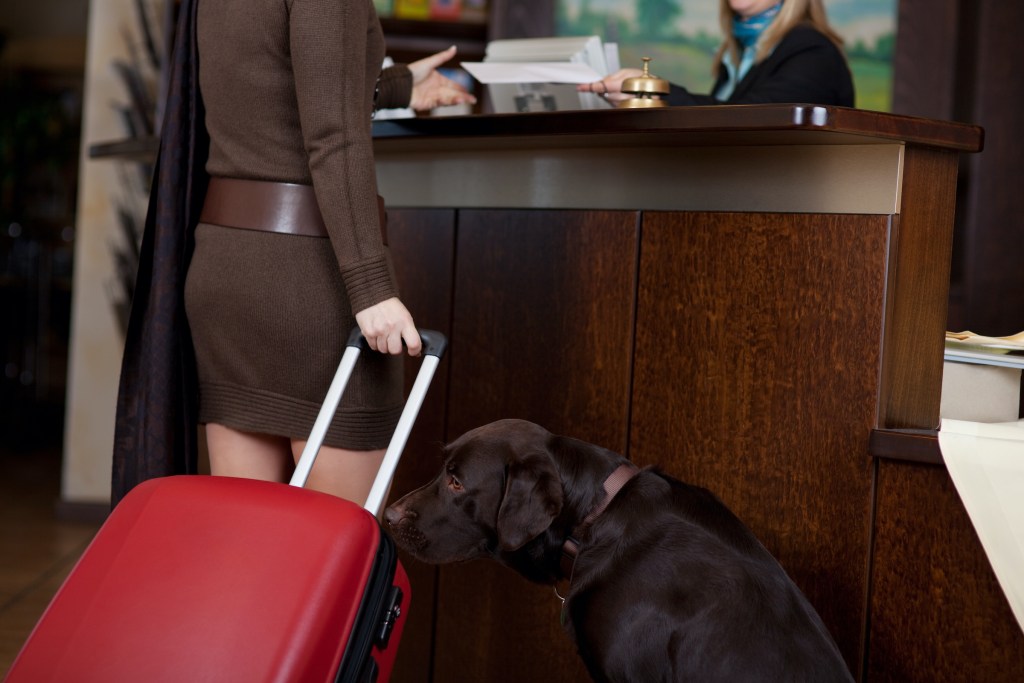Have you been dreaming of that relaxing, worry-free getaway? Did you ever imagine your pet could come, too?
These days, traveling with your dog, cat, or another furry friend is more than possible — it’s pretty easy! Many hotels pride themselves on being pet-friendly, but what exactly does “pet-friendly hotel” mean?
As much as we’d love to give you a one-size-fits-all answer, the meaning of “pet-friendly” can change from hotel to hotel. This is just one reason why it’s a smart idea to browse your hotel’s website — or give them a call — before you go.
So, what does “pet-friendly hotel” mean to different hotels?
What does it mean to be pet-friendly?
Sometimes, a pet-friendly hotel simply welcomes four-legged friends alongside their owners. Other times, these locations offer special accommodations for pets, whether it be a dog park on the property, a room service menu for pets, or even kennel services. No matter what a location’s definition of pet-friendly is, though, they try their best to make the stay as pleasant as possible for both people and their pets.

Pet-friendly hotel rules
When you check in with the concierge, they’ll be able to explain everything you need to know about your visit with your pet: where to take them to relieve themselves, if they’re allowed on beds and furniture, if they can accompany you to the pool, bar, etc.
Apart from following the posted rules and keeping your buddy on a leash or in a carrier, you’ll want to prepare for your trip in a few additional ways.
Brush up on training before you go
You’ll want your best buddy to be on their best behavior while you’re out and about, so make sure to practice training and obedience before your trip. Nearly all hotels and public locations require pets to be in carriers or on leashes anyway, but you’ll always have a backup if your pet can listen to commands.
Bring along all your pet’s belongings
To help your four-legged friend feel at home in the hotel room, you should bring some things from home. Your pet’s bed, a few toys, and identification tags will go a long way in helping everyone feel comfortable. Besides, it’s recommended not to suddenly change your pet’s diet (aside from a few treats, of course), so their usual food is a must-have. Don’t forget the food and water dishes!

What to ask a pet-friendly hotel
Whether you ask upon your arrival, or even before you book, it’s ideal to keep a few questions in mind. Remember, you can call down to the front desk if you’re already in the room and they’ll be happy to answer your questions.
Are all rooms pet friendly?
The most certain way to avoid complications when traveling with your pet is to make sure the hotel knows about them from the get-go. This ensures that when you reserve your room you’ll get the appropriate one and that you won’t be slapped with any surprises when you arrive.
Is there an additional pet fee?
These days, many pet-friendly hotels charge an additional fee on top of your room fee, but the exact amount varies. Of the several hotels listed by the American Kennel Club as some of the most dog-friendly, pet fees vary from $35 to over $100. There may also be a refundable deposit or cleaning fee, so be sure to ask!
There are a few wonderfully generous hotel chains that let pets stay free, including Red Roof Inn. They do have a one pet per room limit and a few other restrictions, though, so be sure to read up on all pet policies before deciding which hotel is for you.
Does housekeeping still enter my room while my pet is present?
When you travel with your pet, you may need to take them for a walk when housekeeping comes by. Alternatively, you may be able to opt out of housekeeping during your stay, so don’t forget to ask about your options.
Are there restrictions as to what pets are welcome?
We’d love to say that all pets are welcome at pet-friendly hotels, but this is not the case. Many locations have restrictions on the species, breed, and weight of animals they allow. Read up on your hotel’s pet policy before you go; the last thing you’d want is to arrive just to find out your pet can’t stay!
Is my pet allowed alone in my room?
Many hotels, no matter how pet-friendly, do not allow animals to stay in the room unsupervised. Even the most well-behaved animals will need to be accompanied by their owners unless otherwise stated, or the deposit may be lost. You might even be charged an additional cleaning fee if your pet makes a mess, so it’s best to err on the side of caution.
When traveling with your pet, keeping these questions in mind will make every bit of the process that much smoother. When you don’t need to worry about hotel details, you can focus on enjoying making memories with your best buddy!



